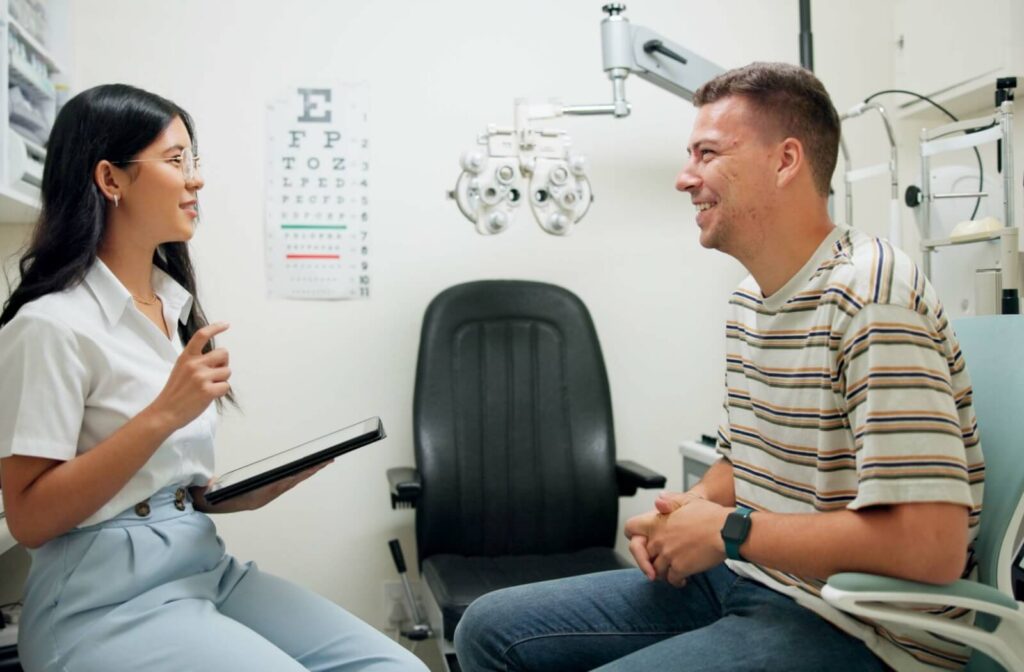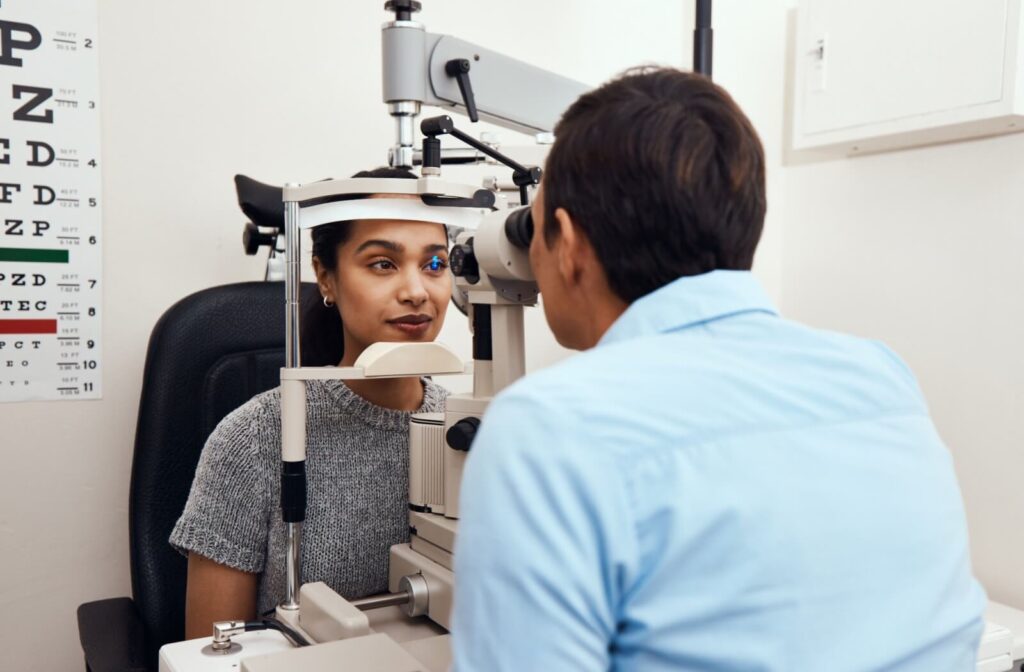One of the benefits of regular eye exams is their ability to shed insight on other health conditions happening in your body. For instance, an eye exam can find signs of diabetes.
How often someone should get an eye exam will depend on personal circumstances, but in general, people aged 18 and older should get their eyes checked every year. However, if you have other health conditions (such as diabetes or high myopia), more frequent exams may be appropriate.
The Relationship Between Diabetes & Eye Health
Did you know there’s a link between diabetes and eye health? Diabetic retinopathy is a common cause of vision loss. This condition happens when high blood sugar levels cause damage to the blood vessels present in the retina. Symptoms include blurry vision, difficulty distinguishing colors, missing or dark areas in vision, and even blindness. Another eye condition associated with diabetes is diabetic macular edema.
An eye exam can identify signs of diabetes before a person is aware they have the condition. This is because a dilated eye exam allows an eye doctor to look closely at the eye’s blood vessels, revealing changes in the vessels that may be concerning. Therefore, regular eye exams are not just good for tracking the development of eye-specific conditions like myopia (nearsightedness) and astigmatism; they can paint a holistic picture of your health too.
However, it’s important to note that while an eye exam can find signs of diabetes, further testing is required to definitively diagnose the disease. If your visit to the eye clinic reveals signs of diabetes, your eye doctor will most likely refer you for further evaluation.
Why Regular Eye Exams Are Important for People With Diabetes
If you’ve been diagnosed with diabetes, regular eye exams are extremely important. According to the American Diabetes Association:
- Adults living with type 2 diabetes should undergo their first eye exam upon diagnosis
- People living with type 1 diabetes should undergo their first eye exam within 5 years of being diagnosed
- After this first exam, everyone with diabetes should get annual eye exams
- Some people may need more frequent eye exams if the eye doctor determines this is appropriate
Learn more about diabetic eye exams here.
Managing Diabetes & Eye Health

There are proactive things you can do to prevent eye disease. Simple habits include:
- Getting your eyes checked regularly: See an eye doctor for a dilated eye exam at least once a year. That way, early intervention for potential problems is possible.
- Managing your blood sugar: The blood vessels in your eyes are vulnerable to damage if you have high blood sugar. Discuss with your healthcare team about ways to manage blood sugar levels. High blood sugar is also linked to blurry vision and changes in the shape of your lenses.
- Prioritize a healthy lifestyle: Staying active and quitting tobacco can also benefit your eye health and manage diabetes.
Other Conditions Eye Exams Can Detect
Did you know eye exams can also detect other health conditions? These include high cholesterol and blood pressure, autoimmune diseases, and even cancer.
High Cholesterol
Cholesterol is a fatty substance in your blood. High cholesterol may manifest in the cornea as a bluish or yellowish ring. This is an especially telling sign of high cholesterol in younger people under 40. Blood vessel deposits are another sign and may indicate a potential stroke (which is life-threatening).
High Blood Pressure
High blood pressure (or hypertension) may cause changes in the appearance of blood vessels. This can be seen in a dilated eye exam. High blood pressure can put you at increased risk of eye diseases like diabetic retinopathy, glaucoma, and macular degeneration, or it can worsen these diseases.
Autoimmune Diseases
Some autoimmune diseases can affect the eyes as well. An autoimmune disease is when the immune system attacks its own body. Autoimmune diseases that may be found through an eye exam include lupus, rheumatoid arthritis, and multiple sclerosis (MS). Symptoms in the eyes may include inflammation, vision changes, pain, redness, and even dryness.
Cancer
Yes, eye exams can even find signs of cancer! Changes in the eye can indicate lymphoma, melanoma-related retinopathy, and metastatic cancer (when cancer spreads to other parts of the body).
Diabetic Eye Exams at Visual Edge Optometric Group
Getting an eye exam can reveal a lot about your general health. Diabetes can lead to troublesome eye conditions like diabetic retinopathy and diabetic macular edema. Early detection of diseases like diabetes can mean earlier intervention and better outcomes.
Our team at Visual Edge Optometric Group is proud to offer diabetic eye exams in Gilroy. We believe that your vision is a precious gift and aim to serve you with integrity and care. Our goal is to build lasting relationships with our patients. We strive to create a warm and comfortable environment to care for their health.
To learn more about diabetes and eye care or to schedule a comprehensive eye exam, book an appointment with us today.


